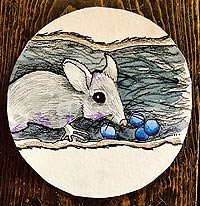 |
| Monty the Pinyon Mouse. |
I’m Monty the pinyon mouse, and I live along the Pinyon Trail Primitive Hiking Loop in Sand Flats Recreation Area. This trail features Utah junipers and two-needle pinyons. Spanish textile traders who came through here called the juniper el enebro; and the two-needle el piñon. Settlers later Anglicized it to “pinyon.”
My neighborhood is on the Colorado Plateau in Núu-agha-tuvu-pu Traditional Territory, the ancestral homelands and historic hunting grounds of the Ute Indian tribe. The people of White Mesa, the Weenuche, are famous for their basketry, weaving, horsemanship, marksmanship, and hunting skills. The Ute word for juniper is pa-waap, and their word for pinyon is tew-waap. Their word for me, a mouse, is poo we chits.
I live inside juniper trees, and I’m an excellent climber. I have to be! Juniper trees can grow to 30 feet tall and pinyon pines can get up to 20 feet high! I use my nose to forage, navigate, and detect coyotes and foxes. I also have very large ears, bigger than my mice cousins. I like hearing happy kids when they hike. I have lots of kids myself.
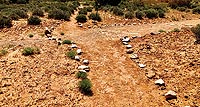 |
| Where the stem meets the loop. |
To hike this trail, drive about 3.5 miles up Sand Flats Road from the Entrance Station (and check out the Prince’s Plumes blooming along the way!), and, just past the Narrows, watch for the sign for the small, rock-lined parking area on the right (west). The trail is an old, mile-long stem-and-loop or “lollipop” bike trail and is now designated for hikers. Take a brochure from the box on the post and follow the rock lining and green dots painted on the rocks.
Utah junipers produce female seed cones (you call them “berries”) in fall and winter, but I have a stash in my den. I also cache other berries and seeds in other trees. I have to hoard them because other animals eat them too. I also eat leaves, grains, insects, and spiders. Branches on a juniper tree rot from the inside out, so I walk, run, and hide from owls in their twisty, dried-out tunnels. It’s like spelunking. Inside a tree! I arrange bark for a cozy den plus emergency nests in other trees.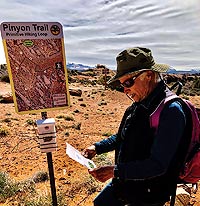
I’m a nocturnal fellow, but I did venture out on a breezy Earth Day (April 22). It’s my favorite day because humans celebrate taking care of animals and plants. The summer solstice is a hard time for me since my hunting time is so short! The Western wallflowers, milkvetch, and curly dock, or “desert rhubarb,” were all blooming. Plus, after our rains this winter and spring, the Mormon tea, claret cup cactus, and those prickly blackbrushes are now all bursting with color.
Other numbered trail posts point out the lumpy biocrust community of organisms on the soil surface, sometimes called the “skin” of the desert; Spindle gall midges whose larvae overwinter on pinyon needles; Lichens, organisms that combine algae and fungi and grow on the rocks; Pinyon pines that provide food for pinyon jays; and Yucca moths that pollinate the yucca plants which serve as nurseries for the moth’s eggs.
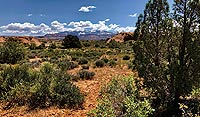
Some of my neighborhood is fragile, and some old “social” trails have been blocked off to restore delicate areas, so keep on the designated trail and respect the trees, even the dead ones. You see a dead tree. I see housing! And remember, Earth Day is every day for me and my family.
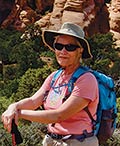
Kathy Grossman is a hiker, artist, climber, and musician who lives in Moab. Her son Monty is also a climber and a musician, though his ears are a normal size. Many thanks to Sonja Nicolaisen for her Pinyon Trail brochure; see also her essential Flower Guide to the High Desert. For more on the Weenuche, check out Robert S. McPherson’s 2011 University of Utah Press publication, As If the Land Owned Us: An Ethnohistory of the White Mesa Utes.
|